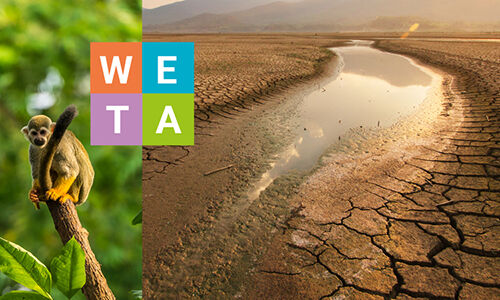Marketing communication
Heatwaves, hurricanes, floods and forest fires threaten our world.
The scariest climate models show that by the end of this century, life as we know it won’t be possible in many places on Earth.1 Yet cutting greenhouse gas emissions is just the tip of the iceberg for a liveable planet: biodiversity loss, while often overlooked, is a global systemic risk on a par with climate change and societal risks.
In fact, the loss of biodiversity and ecosystem collapse is one of the top three threats humanity is likely to face in the next 10 years.2 Over half the world’s total GDP is dependent on nature and is therefore at risk as a result of biodiversity loss.3
Mammal, bird, amphibian, reptile, and fish population sizes have shrunk by more than two-thirds since the 1970s.4 Most of us will have seen David Attenborough’s stark visual evidence of this and understand why it matters.5 However, recent studies suggest that the rate at which animals and plants are going extinct is getting worse than originally feared, largely due to human activity.
In April, for example, researchers found that more than 1 in 5 species of reptiles are now at risk of extinction as humans continue to take away their habitat for farming, urban development, and other industry6. Another study revealed that the combination of climate change and heavy agriculture is having a profound impact on the abundance and diversity of insects – in some areas, overall insect populations dropped by nearly half, with more than a quarter fewer species found7.
How Dire is the Situation?
Human activity is causing unparalleled environmental degradation and contributing significantly to global warming – we’ve already transformed more than 70 percent of the Earth’s land area from its natural state8. Land degradation includes deforestation, desertification and the loss of wetlands or grasslands.
One of the big promises made at COP26 was to not only halt but reverse deforestation by the end of the decade. It’s a tall order when you consider that 11.1 million hectares of tree cover was lost in tropical rainforests in 2021, while primary rainforest – particularly important for carbon storage and biodiversity – was destroyed at a rate of ten football pitches every minute9.
Global Forest Watch, an initiative of the World Resources Institute with partners including the University of Maryland, estimates that this tropical forest loss released 2.5 billion tonnes of carbon emissions – on a par with India’s annual emissions7.
Likewise, oceans play a crucial environmental and socio-economic role for the planet – regulating climates, providing natural resources, enabling international trade, and ensuring livelihoods and food security for a large portion of the world’s population.
What’s Happening to Biodiversity in our Oceans?
Ocean heat content was at a record level in 2020, with areas in temperate zones of the Atlantic and Pacific and towards the poles showing the biggest increases10. One of the starkest effects of this heating can be seen in coral bleaching in places like Australia’s Great Barrier Reef.
Coastal ecosystems such as seagrass, salt marshes and mangroves are also suffering. Kelp, coral and seagrass are «ecosystem engineers»11, building physical structures that create habitats for other life – coral reefs support over a million species, for example – and also provide food and protection to people.
Yet acidification caused by dissolved carbon dioxide will also affect a wide range of organisms, from fish to algae.
The oceans absorb about 30 percent of our emissions and their pH has fallen by 0.1 units since industrial times, making the water far more acidic. This, in turn, is pushing the Earth’s oceans toward a mass extinction event at a level not seen in about 250 million years, when scientists believe up to 90 percent of marine organisms went extinct due to overheated, acidic and deoxygenated oceans12.
Uncontrolled human activities are therefore putting the health of our oceans under threat, adversely affecting their biodiversity, their capacity to mitigate climate change, and putting at risk many communities’ sources of incomes and food. A disaster looms if we don’t act now.
|
GLOSSARY
|
1 Source: Mapping where the earth will become uninhabitable, Berliner Morgenpost, 2022
2 Source: World Economic Forum’s 2022 Global Risks Report
3 Source: World Economic Forum’s 2020 New Nature Economy Report
4 Source: WWF, The Living Planet Report 2020
5 Source: BBC, Extinction: The Facts, 2020
6 Source: New York Times, April 2022
7 Source: Nature, April 2022
8 Source: United Nations Convention to Combat Desertification, Global Land Outlook 2022
9 Source: Global Forest Watch, April 2022, research
10 Source: Climate change: A status report, New Scientist, April 2021
11 Source: Bridging the gap between coastal engineering and nature conservation, Philipp Jordan & Peter Fröhle, Journal of Coastal Conservation, February 2022
All investing involves risk, including the risk of capital loss. This material is provided for informational purposes only and should not be construed as investment advice, or a recommendation or an offer to buy or to sell any security, or an offer of services. Investors should consider the investment objectives, risks and expenses of any investment carefully before investing. The views and opinions expressed are as of the date indicated, and may change based on market and other conditions. There can be no assurance that developments will transpire as forecasted. In Switzerland: This material is provided by Natixis Investment Managers, Switzerland Sàrl, Rue du Vieux Collège 10, 1204 Geneva, Switzerland or its representative office in Zurich, Schweizergasse 6, 8001 Zürich.






